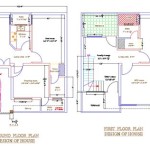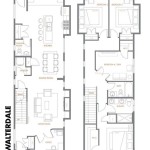Essential Aspects of House Floor Plan With Dimensions And Elevations
Creating a house floor plan is a crucial step in the home design process. A well-designed plan ensures that your home is functional, efficient, and meets your specific needs. In this article, we will delve into the essential aspects of house floor plans, including dimensions, elevations, and other important considerations.
Dimensions
Dimensions play a vital role in creating an accurate floor plan. Measurements should be precise to ensure that furniture, appliances, and other elements fit comfortably within the space. Typically, dimensions are indicated in feet and inches, and they should include the length, width, and height of each room.
Elevations
Elevations, also known as floor plans, provide a detailed overview of a house's vertical structure. They show the height of walls, windows, doors, and other features. Elevations allow you to visualize the layout of the home from different perspectives and ensure that there is sufficient headroom and proper ventilation.
Scale
The scale of a floor plan determines the accuracy and usability of the document. A common scale is 1/4 inch = 1 foot, which means that 1/4 inch on the plan represents 1 foot in the actual building. Choosing the appropriate scale ensures that the plan is readable and easy to understand.
Space Planning
Space planning involves efficiently arranging rooms and elements within the floor plan. Consider the flow of traffic, furniture placement, and the relationship between different spaces. Aim for a balanced and functional layout that maximizes space utilization and allows for comfortable movement.
Zoning
Zoning is the designation of specific areas within the floor plan for different activities. Common zones include public spaces (living room, dining room, kitchen), private spaces (bedrooms, bathrooms), and service spaces (laundry room, storage). Zoning helps create a cohesive and organized floor plan.
Circulation
Circulation refers to the movement of people and air throughout the house. Consider the placement of hallways, doors, and windows to ensure smooth traffic flow and adequate ventilation. Door swings and clearances should also be carefully planned to prevent obstructions.
Structural Considerations
The floor plan should take into account structural considerations such as the location of load-bearing walls, columns, and beams. These elements dictate the layout and design of the house and should be carefully integrated into the plan.
Electrical and Plumbing
Electrical and plumbing layouts should be incorporated into the floor plan to determine the placement of outlets, switches, fixtures, and piping. This ensures that the home is equipped with the necessary infrastructure for electricity, water, and drainage.
Other Considerations
In addition to the essential aspects mentioned above, other considerations may include:
- Accessibility: Ensure that the floor plan meets accessibility standards for individuals with disabilities.
- Sustainability: Consider energy-efficient designs and the integration of sustainable materials.
- Personalization: Tailor the floor plan to reflect your specific lifestyle and preferences.
Conclusion
Creating a comprehensive house floor plan with dimensions and elevations is essential for ensuring a functional, efficient, and aesthetically pleasing home. By carefully considering these aspects, you can design a space that meets your needs and enhances your quality of living. Remember to consult with a qualified architect or designer to ensure the accuracy and professionalism of your floor plan.

Floor Plan And Elevations For The New House Wildfire Interiors

Pin On My Saves

Architecture House Plan And Elevation Complete Drawing Cadbullb Bungalow Floor Plans Building Designs

Scheme Of The Tested Single Family House A Front Elevation B Scientific Diagram

Floor Plan And Elevation Of Modern House Plans Bungalow Ground

Floor Plan Of The House With Elevation Details In Dwg File Which Provide Detail Front Side Ele Plans Drawing Simple

Row House Plan With Detail Dimension In Autocad Drawing Simple Plans Open

How To Draw Elevations

Plan And Elevation Of The Test House A Floor Ground Scientific Diagram

How To Read House Plans Floor Building In 10 Minutes Archid








